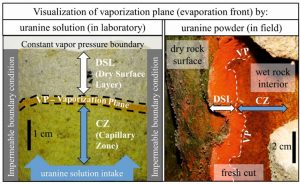 The vaporization plane in porous media separates the region of capillary flow from the dry surface layer, where the water transports in its gas phase. Knowledge of the depth and geometry of the vaporization plane is critical for estimating water flux in the soil-atmosphere interphase, for understanding evaporation processes in general, and for prediction of damaging salt crystallization locations. Use of sodium fluorescein (called also uranine) to visualize the vaporization plane in porous media in both laboratory and field experiments is presented. The property of uranine solution to change its color according to its concentration is used to: i) visualize the vaporization plane by forming a distinctive dark-orange zone where the pore water evaporates, and ii) to distinguish the zone of vapor flow from the zone where capillary flow is present. A complex-shaped vaporization plane in hydrophobic materials is also detectable. Uranine powder, when applied onto a porous material, clearly visualizes the dry surface layer and the capillary zone, divided by the vaporization plane.
The vaporization plane in porous media separates the region of capillary flow from the dry surface layer, where the water transports in its gas phase. Knowledge of the depth and geometry of the vaporization plane is critical for estimating water flux in the soil-atmosphere interphase, for understanding evaporation processes in general, and for prediction of damaging salt crystallization locations. Use of sodium fluorescein (called also uranine) to visualize the vaporization plane in porous media in both laboratory and field experiments is presented. The property of uranine solution to change its color according to its concentration is used to: i) visualize the vaporization plane by forming a distinctive dark-orange zone where the pore water evaporates, and ii) to distinguish the zone of vapor flow from the zone where capillary flow is present. A complex-shaped vaporization plane in hydrophobic materials is also detectable. Uranine powder, when applied onto a porous material, clearly visualizes the dry surface layer and the capillary zone, divided by the vaporization plane.
Weiss T., Slavík M., Bruthans J. (2018): Use of sodium fluorescein dye to visualize the vaporization plane withinporous media. Journal of Hydrology 565, 331–340. (DOI)








